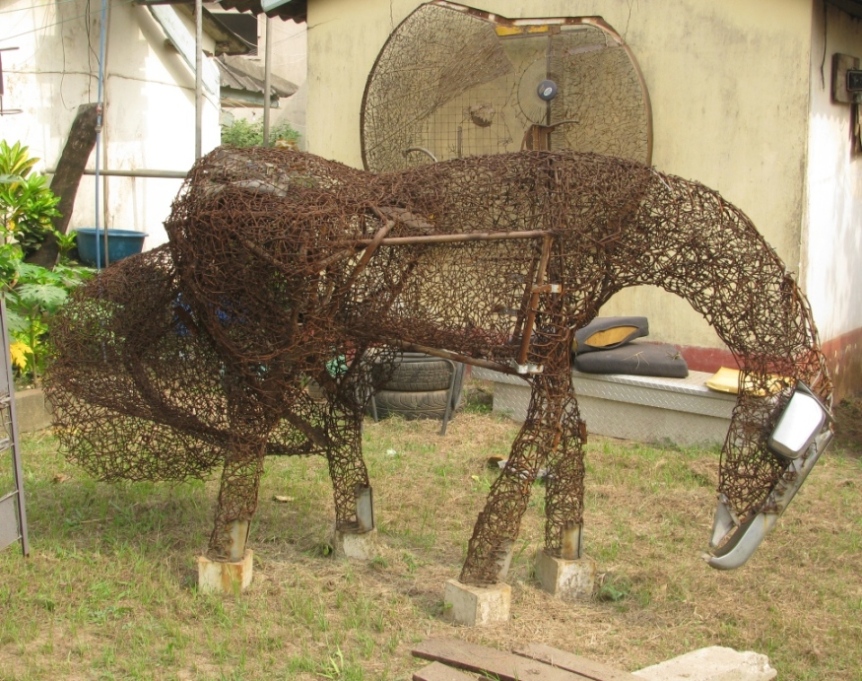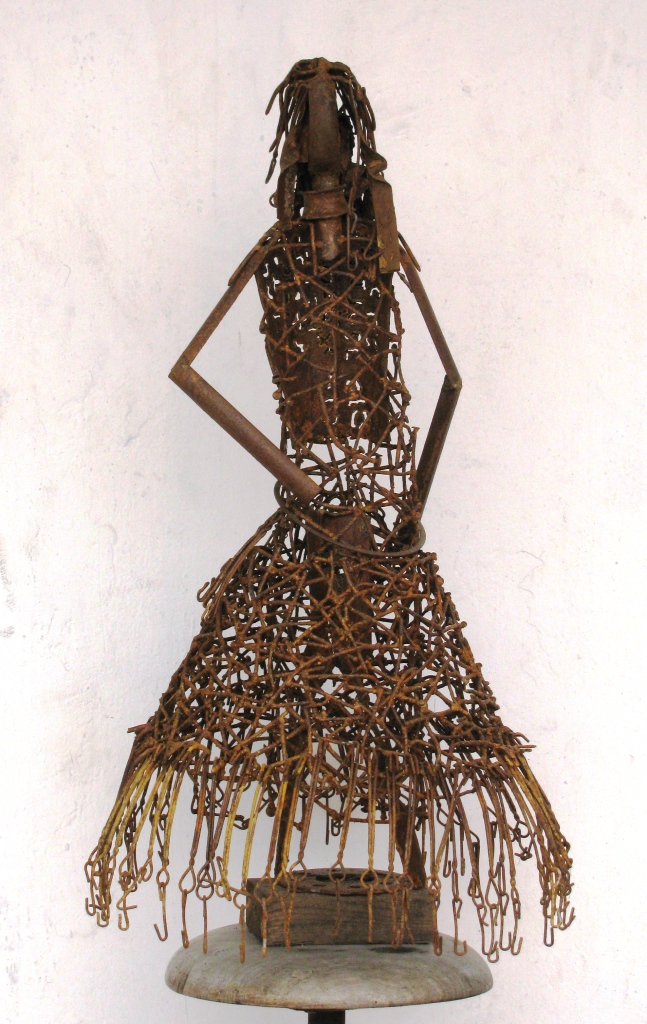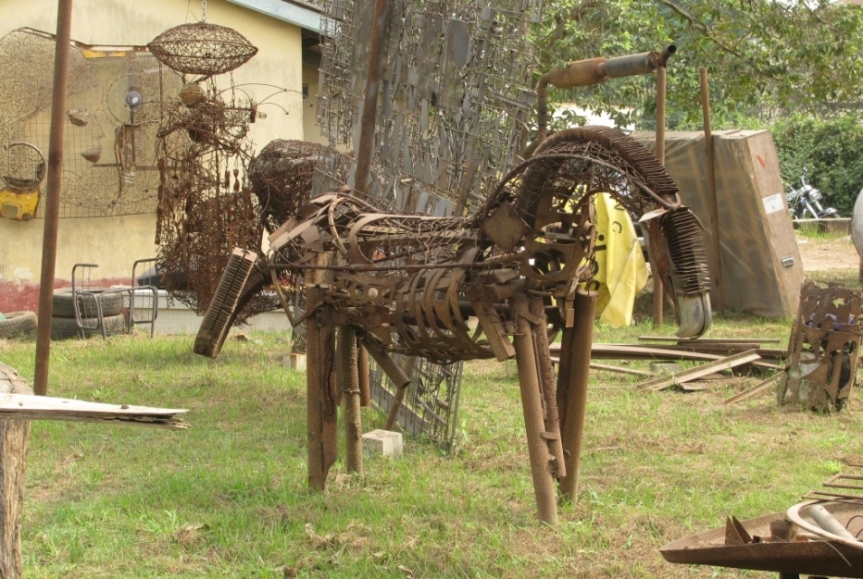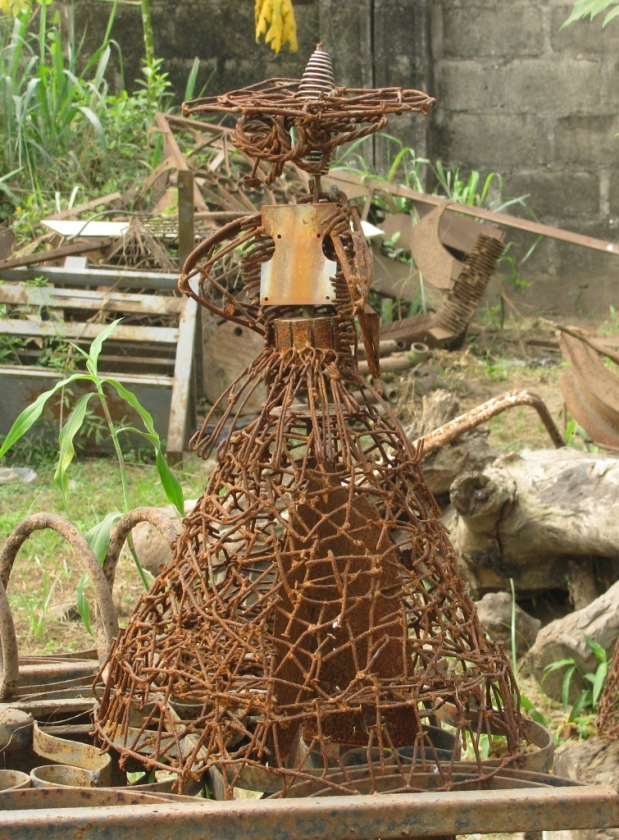Olu Amoda is not an ordinary Nigerian artist. His quiet and unassuming character veils a fiery spirit. He was born in Warri and he remains a “warri man”. The many years spent in Lagos have not dampened his readiness to enter into a “good fight” if the cause is worth. And he seems to find plenty of good causes.
I visited him recently. He works in two studios; one near Yabatech, where he is a lecturer, and the other in Mende. This was a rare privilege. One thing is to see his works in a “sanitized”, controlled environment and another is to see them in the open. They stand there, rusting quietly under the sun and rain while they mix with discarded bits and pieces, uncompleted works and “real life” objects (cloths hanging from a drying line, the papaw tree growing among his works, the discarded tyres…). His complete yard (drying lines included) would make a wonderful installation fitting for the Tate Modern or any other large exhibition space.

His recent stay abroad (almost four years) has not changed him much. He remains the artist that he was, and he is still the committed teacher that he has always been since he came to Yabatech more than twenty years ago. Clearly, Olu likes working with his students. A few days ago I met a young artist who had been taught by Olu in Yabatech. He told me the story of how one day Olu came to the classroom and announced that the next assignment would be “the mind of a Nigerian policeman”. The students were more than a little bit surprised. Olu told them to first figure out what was in the mind of a Nigerian policeman, then produce some sketches of works on that topic and finally to start producing a work. Olu did not tell them much about materials, styles, etc. His teaching approach was novel to the students, and it seems they loved it.
In his recent works there is an increasing interest on the intersection of literature, life and visual arts. Two of the works in his yard are part of a broader project. They are two horses that can be interpreted at different levels: they point at the two horses in the Nigerian coat of arms, but they are also a reference to two of the main characters in George Orwell’s novel “Animal farm”: the horses Boxer and Clover. His use of references is eclectic, he showed me also some pieces of a series of “bulls” he is doing using old bicycle handle bars as the horns of the bull. For a Spaniard like me, the figure of a bull resonates with multiple meanings. Olu incorporates some of them, but he also sees the bull as a metaphor of the “bully” (the big man syndrome) in the Nigerian society. He also mentioned the references to Fela’s song: “Roforofo fight”. I found interesting that this interplay of references, metaphors and symbols is embodied in physical works. These works are not mere decorative objects or dry unintelligible discourses on societal issues. These are real art works of great strength and formal quality.
Olu Amoda loves to use discarded materials, or as he prefers to call them “re-purposed materials”. For years, the ordinary steel nail has been a recurrent component of his works. For him a nail is a metaphor and symbol of linkage, bonding together separate (in many cases, disparate) items. He likes to use the nails recovered from pallets, crating boxes or carpentry work. In his own words: “Nails are used in my work as a metaphor. They have survived generations and remain one of the most ideal and enduring pieces of engineering. Nails depend on the notion of shared responsibilities, like ants. Small but lethal, a nail is able to defend itself, but yields to the will of the craftsman. What we call little things are merely the causes of great things: they are the beginning, the embryo and the point of departure, which generally speaking, decides the whole future of an existence.”
We had a long conversation. He told me about his preoccupation to produce works of art that are not only meaningful and capable of questioning peoples, mores and institutions, but also artworks that are beautiful. He told me about the positive developments and the good support he has from Rukeme Noserime, Adeola Balogun and other colleagues in Yabatech. We also spoke about the need to help young artists to develop professionally. I hope we can soon do something together. I am already impatient to see what it will be.
There are few teachers like him and there are even less artists like him. His students are lucky to have him back and a few of us are fortunate to have been given a “tour of his yard”, even if no time was left for a drink…







